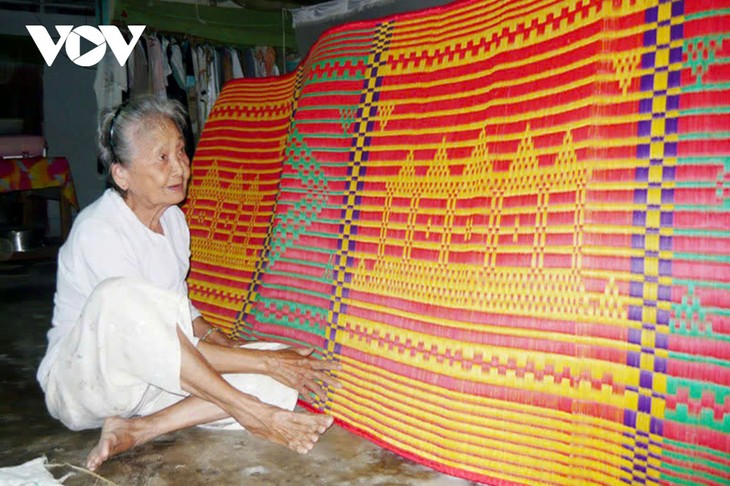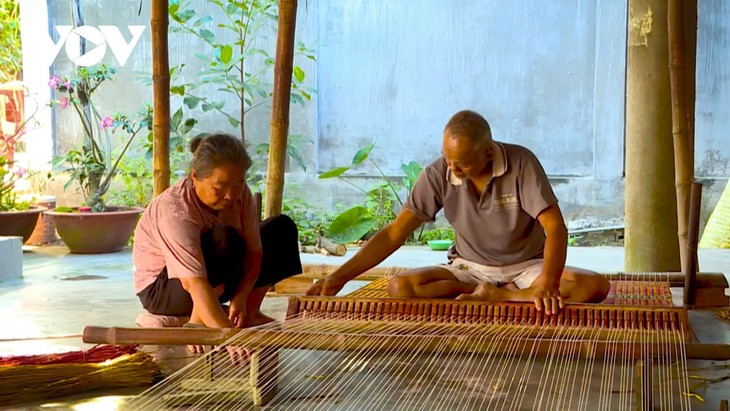(VOVWORLD) - 80% of the Khmer ethnic people who live in Ca Hom-Ben Ba village in Ham Tan commune, Tra Vinh province, are engaged in the craft of mat weaving. Mat weaving began there in 1920 after local women visited relatives in the southernmost province of Ca Mau province and learned it. Upon their return, they cut sedge, split it into fibers, dried it, asked the local men to build looms, and started weaving. Their first sedge mats were very rough and clumsy but they used them instead of buying mats at the market. The mats improved and by the 1940s, the whole village was making mats and selling them at the market. The craft village’s golden age was the 1960s.
 Ca Hom-Ben Ba mats are very durable, lasting as long as five years without rotting or fading. Ca Hom-Ben Ba mats are very durable, lasting as long as five years without rotting or fading. |
Large mats are 1.6 by 2 meters and small mats are 1 by 1.9 meters. There are white mats, colored mats, floral-print mats, and text-print mats. The most distinctive is the floral-print mat of five colors – white, red, green, yellow, and purple.
The making process is basically the same as in the south: select old, long sedge stalks, dry them, boil them, and dye them. What distinguishes Ca Hom-Ben Ba mats is that they are very durable, lasting as long as five years without rotting or fading. But the 100-year-old secret has never been revealed.
According to Kim Hoa, a mat weaver in Ca Hom hamlet, the villagers do all the work manually. She told VOV, “We dye the mat with bright colors, emboss it manually, and pierce the holes evenly so that the finished mat is beautiful.”
Ly Thi Ha, a resident of Ben Ba, recalled that in the 1960s, the price of local mats was 40% higher than Ca Mau mats of the same type. But they couldn’t make enough mats to keep up with the demand. Every household in the village had at least three looms operating at full capacity.
“In a day my husband and I can weave only two mats, which sell for about 4 dollars each. It takes several days to dye a mat the first time. After it dries, we dye it a second time,” said Ha.
By the 1970s, the appearance of nylon mats made it harder for the village to compete. But shortcomings like not being able to absorb sweat or dissipate heat quickly revealed themselves and restored the rightful position of Ca Hom-Ben Ba mats in the hearts of consumers.
By the 1990s, the mat weaving village once again was on the verge of extinction because the villagers could not obtain sufficient raw materials and their mats were competing against more modern designs.
 Artisan Ngo Thi Pho is well-known for double-sided flower mats to serve luxury clients. Artisan Ngo Thi Pho is well-known for double-sided flower mats to serve luxury clients. |
So, an artisan named Ngo Thi Pho designed new patterns, varied the colors, and started weaving double-sided mats. In 2000, double-sided flower mats appeared in the market under the Ngo Thi Pho brand. Some were ordered by the Cambodian clients for use in the main halls of pagodas and towers.
In 2001, Ham Tan commune developed a project to fund loom making for 40 poor households and asked Ngo Thi Pho to teach them how to weave the double-sided flower mats. Since then, Ca Hom-Ben Ba village has recovered. It currently has 450 households engaged in mat weaving, employing 400 weavers and 1,500 workers growing sedge, processing raw materials, and mixing dyes.
Ca Hom-Ben Ba village produces 150,000 mats per year. The Hàm Tân mat cooperative gathers local producers to ensure stable, sustainable production, improve product quality, and expand the market. Ca Hom-Ben Ba mats are available throughout the Mekong Delta and southeastern Vietnam.
Mat seller Do Thi Mai Hoa said, “In one year, I sell 7,000 mats which I buy only from Tra Vinh province because the mats there are of good quality. They’re in great demand from December to Lunar New Year in late January and early February.”
In August 2024 the art of making Ca Hom mats by Khmer people in Tra Vinh province was recognized as a National Intangible Cultural Heritage.